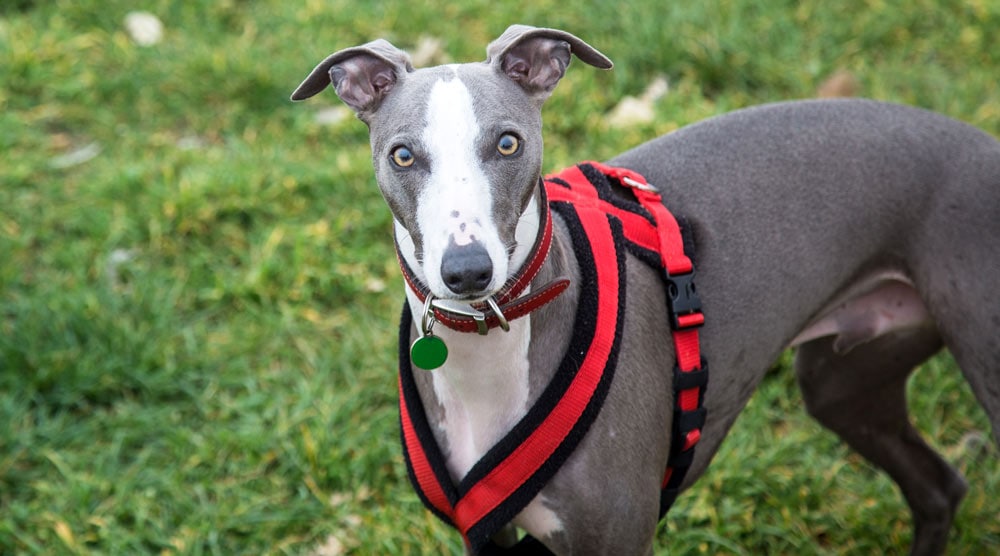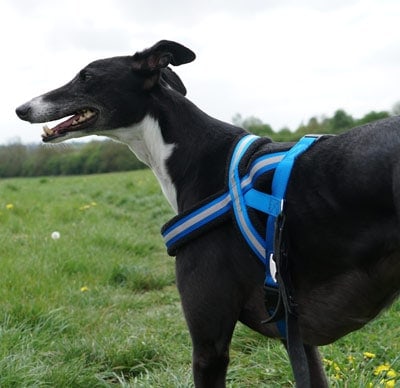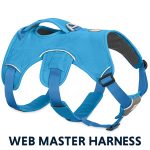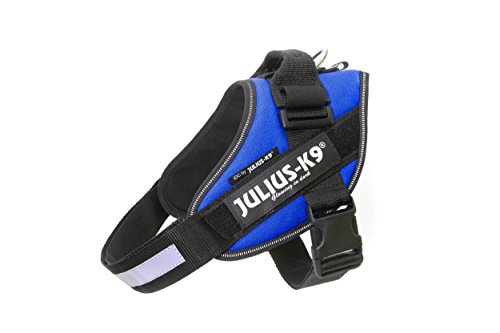Not sure which dog harness to buy for your greyhound? Here are five of the best greyhound harnesses, along with tips to help you choose the right option for your dog.

Contents
This loving breed’s slim face, long neck and deep chest means many of the best harnesses don’t fit. A greyhound’s thin skin is also prone to wounds caused by chafing.
It’s vital for a greyhound to be securely leashed on a walk though. Aside from being the fastest dog breed, many (but not all) greyhounds have a strong prey drive and may chase small animals – including other dogs. This is often more prevalent in ex-racers, although not all racing dogs have a strong prey drive.
This article will discuss the pros and cons of a greyhound harness, how to choose the right option for your pet, and five of the best options.
Our #1 Pick: Ruffwear Webmaster
Padded, virtually escape-proof, and great for greyhounds
My top pick for a greyhound harness is the Ruffwear Webmaster. The extra belly strap makes it very difficult to escape from, and the padding is comfortable for your dog’s skin. It’s also highly durable.
Why Use a Dog Harness?

I believe harnesses are the safest option for most dogs – but there are pros and cons to using one.
The biggest advantage is that harnesses spread force across the dog’s chest and shoulders, rather than concentrating it on a delicate greyhound’s neck. Walking on a collar, in contrast, has been linked to eye glaucoma, tracheal collapse and chronic back pain.
Harnesses also provide “kind” control. They don’t cause pain or tightening, unlike choke chains, prong collars and other negative devices.
There are a few drawbacks though. Harnesses may encourage pulling in some dogs, although a front-clip can help prevent this. It can also be hard to find a harness that properly fits a greyhound.
Most importantly, greyhounds are notorious for slipping free of both collars and harnesses. This could be disastrous – especially if your dog’s prey drive causes it to run across a road or attack another dog.
In reality, many greyhounds are happy to walk politely on a harness and won’t try to escape. If your pet is an escape artist, however, then be very careful about which harness you use.
For extra safety, you could try a dual leash that’s attached to both an escape-proof harness – such as the Ruffwear Webmaster – and the dog’s collar. Make sure the tension is only on the harness attachment though, leaving the collar slack unless your pet somehow backs out of the harness.
Types of Harness for Greyhounds
There are several types of harness available. These include:
- Front-Clip. These harnesses have a D-Ring or other leash attachment on the dog’s chest. They are sometimes called “no pull” harnesses, as they guide the dog in a circle when he pulls. If your dog is a puller, front-clip harnesses are a great choice for encouraging polite walking without causing pain.
- Rear-Clip. Traditional harnesses have a leash attachment on the dog’s back. They provide decent control of your dog, but don’t discourage pulling. An advantage is that rear-clip harnesses make it less likely that your dog’s leash gets tangled around his front legs.
- Dual-Clip. Some harnesses, such as the Ruffwear Front Range, have both front and rear clips. They are the most versatile choice, plus they provide the option of using a dual-leash to get the best of both worlds.
For a greyhound, a front-clip no-pull harness can limit pulling without causing pain. If your dog doesn’t pull, however, a rear-clip harness is probably the best choice.
Tip: Is your greyhound fearful of his harness? You may want to read our harness training guide for fearful dogs.
What Makes a Great Greyhound Dog Harness?
Aside from the type, here are other considerations when choosing a greyhound dog harness:
- Soft and Padded. Greyhounds have a short coat and thin skin. Padding can prevent chafing or sore spots, while also keeping your pet warm.
- Strong Buckles and Hardware. While most greyhounds have a laid-back attitude to life, they are relatively heavy dogs. Look for a harness with strong hardware and metal leash D-rings. Durable nylon or tough webbing can also ensure that the harness will last more than a few walks.
- Correct Size. Aside from padding, getting the correct size is the best way to prevent chafing. A properly fitted harness is also more difficult to escape from.
- Adjustable Design. All harnesses have some level of adjustment, but the best have multiple adjustment points. Greyhounds have a unique body shape, so look for a harness with several adjustment options to get a snug fit.
- Washable. Dog harnesses quickly become dirty, so make sure it can withstand repeated washing. Unfortunately, many of the best greyhound harnesses are not suitable for machine washing, so you’ll need to clean by hand.
Always check a harness fits after buying it, and don’t be afraid to exchange it for a different size if necessary. Keep a close watch for signs of chafing, rubbing, slipping or excessive movement, as this can quickly cause pressure wounds.
While the harness shouldn’t be too tight, you should also check that your greyhound is secure and unable to escape.
Note: If your dog is a determined escape artist, you may need to take extra steps to keep him safe. A spook harness, for example, could be a good option. These aren’t as comfortable or padded as alternatives, but are designed for nervous greyhounds. As I mentioned earlier, a double leash attached to both the collar and harness can also provide extra security – but make sure all the tension goes through the harness.
5 Best Dog Harnesses for Greyhounds
Listed below are my five favourite greyhound harnesses. Make sure you read each review carefully to find the right option for your dog.
Note: I haven’t included any martingale collars, slip collars, or other devices that cause uncomfortable tightening or pain.
The Ruffwear Webmaster is my top pick for a greyhound harness – especially those prone to escaping. No harness is 100% escape proof, but the Webmaster comes close. It’s also easy to adjust, has a reflective trim, and comes with plenty of padding.
With an extra rear belly strap, the Webmaster is more secure than the average dog harness. If your greyhound is an escape-artist, the Webmaster is probably the only harness you should consider.
There are also five adjustment points to get a snug fit without causing chafing or restricting your greyhound’s movement. As it’s difficult to get a good fit on most greyhounds, the ability to customise the Webmaster is an important feature.
While the nylon straps aren’t completely padded, there is soft padding over areas that are most likely to chafe. Ruffwear has also included a designated section for custom patches.
I also like that the Webmaster has a built-in handle. This is useful if you need quick control of your dog, or if he needs help getting into a car or up steps.
There aren’t many drawbacks to the Ruffwear Web Master harness. It’s expensive, but I think it’s worth the money – especially for escape artists. I wish it had a front leash attachment to discourage pulling though.
The Ruffwear Webmaster is one of the best harnesses for escape-prone dogs. The extra rear strap keeps your dog safe and secure, while the five adjustment points allow for a snug fit. It’s also padded and durable.
- Type: Rear
- Sizes: XX-Small, X-Small, Small, Medium, Large
- Price Range: $$$
- Virtually escape proof
- 5 adjustment points
- Padded straps
- Strong D-ring
- Expensive
- Bulkier than other options
The PetSafe Sure-Fit doesn’t have any padding – so why am I recommending it? The simple reason is that it’s one of the easiest harnesses to adjust to a greyhound’s unusual body shape. If your dog doesn’t pull, it could be a good option.
Unlike many harnesses with a similar design, the PetSafe Sure-Fit has five adjustment points – including the option of adjusting the distance between chest and belly straps. This makes it possible to get a precise fit on almost any dog breed, including greyhounds.
It’s also a durable harness, with strong nylon straps and a steel leash attachment.
The biggest downside is the lack of padding. If your greyhound has a habit of pulling, I recommend choosing the Webmaster instead. I also wish the straps were wider, as this would reduce the chance of chafing.
For calm and polite walkers, however, the PetSafe Sure-Fit is a decent choice for greyhounds.
The Sure-Fit doesn’t have padding, so I don’t recommend it for pullers. For getting a proper fit on a deep chested greyhound, however, it’s one of the best options.
- Type: Rear
- Sizes: Extra Small, Small, Medium, Large
- Price Range: $
- 5 adjustment points
- Suitable for deep chested breeds
- Cheap
- Not padded
- No front D-ring
For greyhounds that don’t have a habit of escaping, the Ruffwear Front Range is an excellent choice. It’s durable, easy to adjust, and has both front and rear leash attachments. The harness also comes with plenty of padding to protect your dog’s skin. The Webmaster is a better choice for escape-prone greyhounds though.
The Ruffwear Front Range is a no pull dog harness. By attaching the leash to the front attachment, your greyhound is gently guided in a circle when he tries to pull. This won’t prevent all pulling, but can reduce the intensity without causing pain.
It’s also a well-built harness. The nylon straps are tough and durable, while padding covers the belly, chest and armpits to prevent chafing. It also comes with four adjustment points and a reflective trim.
With that said, it’s not as easy to adjust to a greyhound’s unusual body shape as the Webmaster or Sure-Fit, as you can’t change the distance between the front and belly straps. It’s also not the best option for Houdini dogs, as the lack of an extra rear strap makes it easier to back out from.
For calm greyhounds who don’t try to escape, however, it’s one of the most comfortable harnesses on the market.
The Ruffwear Front Range is one of the most popular dog harnesses on the market. It’s strong, has a no-pull front leash attachment, and four adjustment points for getting a good fit.
- Type: Front & Rear
- Sizes: XX-Small, X-Small, Small, Medium, Large
- Price Range: $$
- Both front and rear leash attachment points
- Lots of padding
- 4 adjustment points
- Not as escape-proof as the Webmaster
- Front least attachment is fabric rather than metal
- Not as easy to adjust to a greyhound’s shape as the top harnesses on this list
The PetSafe EasySport is a relatively cheap harness that has more padding than the Sure-Fit. It’s not as adjustable as some of the other options on this list, but is a decent choice for a calm greyhound who doesn’t have a habit of “backing out.”
Unlike most harnesses, the EasySport has an elastic neckline. This can’t be directly adjusted, but conforms (slightly) to your dog’s chest. It also has an adjustable belly strap and is easy to put on.
Other features include a built-in handle, which is useful when you need quick control, and five colour options.
The EasySport certainly isn’t as easy to fit to a greyhound’s shape as the Webmaster or Sure-Fit though. I also don’t think it’s as durable as the best greyhound harnesses.
For dogs that don’t try to escape, or those that need extra padding, it provides excellent value though.
The PetSafe EasySport harness provides plenty of padding to protect your greyhound’s skin. It also has an elastic neckline, which may help to get a comfortable fit, and a built-in handle.
- Type: Rear
- Sizes: X-Small, Small, Medium, Large
- Price Range: $
- Great price
- Handle
- Metal D-Ring
- Lots of padding
- Not as adjustable as other options
- Not the strongest on the market
While the Julius K9 PowerHarness isn’t the best greyhound harness, it’s worth considering if you need an ultra-durable harness for a calm dog. It may not fit all greyhounds though.
I’m a big fan of the Julius K9 IDC. It’s a strong and durable harness, with a padded design and reflective edges. The harness is also built with adjustable belly and front straps for getting a snug fit.
Unfortunately, the IDC won’t fit all greyhounds. It has two adjustment straps, but you may need to experiment to find out whether it’s suitable for your greyhound. A harness with five adjustment points would be better for greyhounds with particularly deep chests, for example.
It’s also not the best choice for escape artists. The compact design makes it too easy to “back out.”
If it fits your dog, however, the Julius K9 is one of the best harnesses on the market.
The Julius K9 IDC is an outstanding dog harness that’s durable, comfortable and easy to adjust. It’s not the best choice for adjusting to a greyhound’s body shape though.
- Type: Rear
- Size: Variety
- Price Range: $$$
- Strong with heavy duty buckles
- Two adjustable straps
- Available in a variety of sizes and colors
- Not the best for a greyhound’s body shape
- Expensive
Frequently Asked Questions
How Do I Know If I Bought the Right Size?
Getting the right size is essential for your dog’s comfort and safety. Even the best harness could be unsafe if it isn’t correctly fitted. All manufacturers provide sizing charts, so measure your dog’s neck and chest girth carefully and follow the instructions as closely as possible.
Once you’ve bought and adjusted a harness to your dog’s body shape, you should check that it’s not too tight or loose. As a general rule, you should be able to fit two fingers between your dog’s skin and the harness. Any more space could make it easier for your dog to slip out, but making it too tight could cause chafing.
Are These Harnesses Suitable for an Italian Greyhound?
Italian greyhounds are small dogs compared to greyhounds – but have a similar body shape. The harnesses above should be suitable, as long as they are sized correctly. This is also true for other breeds with similar shapes, such as a lurcher and saluki.
Summary and Final Thoughts
Choosing a harness for greyhounds can be difficult. Their deep chest, thin head and long neck means that many harnesses don’t fit or fail to provide enough security.
My top recommendation for a greyhound harness is the Ruffwear Webmaster. It’s a strong option that’s virtually impossible to escape from, which is important for greyhounds. The Webmaster is also padded and has five adjustment points, making it easy to adjust to a greyhound’s body shape.
Do you have any questions about choosing a greyhound harness? Please let me know in the comments section below.






